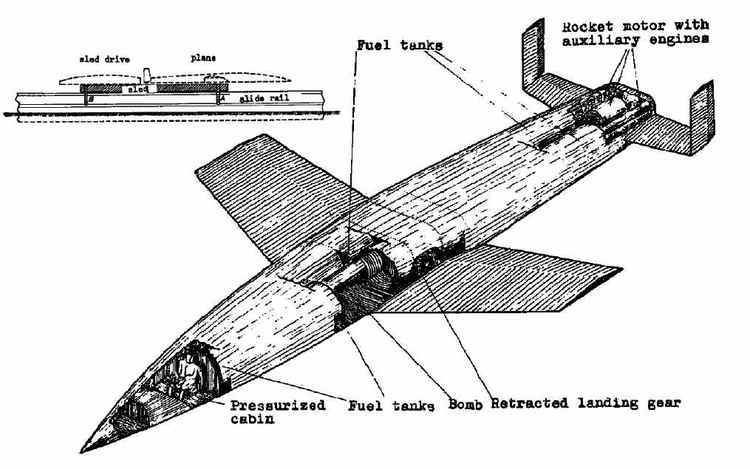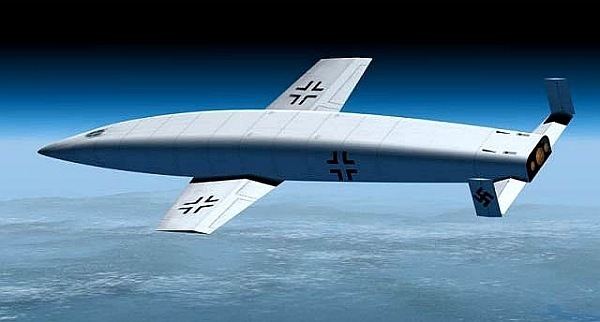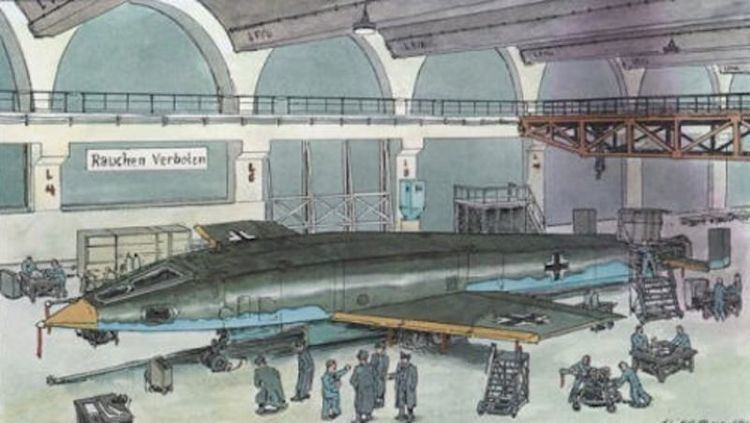Wingspan 15 m | Length 28 m | |
 | ||
Der silbervogel a nazi rocket powered suborbital bomber
Silbervogel, German for silver bird, was a design for a liquid-propellant rocket-powered sub-orbital bomber produced by Eugen Sänger and Irene Bredt in the late 1930s for The Third Reich/Nazi Germany. It is also known as the RaBo (Raketenbomber or "rocket bomber"). It was one of a number of designs considered for the Amerika Bomber mission, which started out in the spring of 1942 being focused solely on trans-Atlantic range piston-engined strategic bombers, like the Messerschmitt Me 264 and Junkers Ju 390, the only two airframe types actually built and flown for the competition. When Walter Dornberger attempted to create interest in military spaceplanes in the United States after World War II, he chose the more diplomatic term antipodal bomber.
Contents
- Der silbervogel a nazi rocket powered suborbital bomber
- Silbervogel orbital bomber
- Concept
- History
- Postwar
- Snger Raumtransportsystem
- References

Silbervogel orbital bomber
Concept
The design was a significant one, as it incorporated new rocket technology, and the principle of the lifting body, foreshadowing future development of winged spacecraft such as the X-20 Dyna-Soar of the 1960s and the Space Shuttle of the 1970s. In the end, it was considered too complex and expensive to produce. The design never went beyond mock up test.

The Silbervogel was intended to fly long distances in a series of short hops. The aircraft was to have begun its mission propelled along a 3 km (2 mi) long rail track by a large rocket-powered sled to about 800 km/h (500 mph). Once airborne, it was to fire its own rocket engine and continue to climb to an altitude of 145 km (90 mi), at which point it would be travelling at some 5,000 km/h (3,100 mph). It would then gradually descend into the stratosphere, where the increasing air density would generate lift against the flat underside of the aircraft, eventually causing it to "bounce" and gain altitude again, where this pattern would be repeated. Because of aerodynamic drag, each bounce would be shallower than the preceding one, but it was still calculated that the Silbervogel would be able to cross the Atlantic, deliver a 4,000 kg (8,800 lb) bomb to the continental United States, and then continue its flight to a landing site somewhere in the Empire of Japan–held Pacific, a total journey of 19,000 to 24,000 km (12,000 to 15,000 mi).
Postwar analysis of the Silbervogel design involving a mathematical control analysis unearthed a computational error and it turned out that the heat flow during the initial atmospheric re-entry would have been far higher than originally calculated by Sänger and Bredt; if the Silbervogel had been constructed according to their flawed calculations the craft would have been destroyed during re-entry. The problem could have been solved by augmenting the heat shield, but this would have reduced the craft's already small payload capacity.
History
On 3 December 1941 Sänger sent his initial proposal for a suborbital glider to the Reichsluftfahrtministerium (RLM) as Geheime Kommandosache Nr. 4268/LXXX5. The 900-page proposal was regarded with disfavor at the RLM due to its size and complexity and was filed away. Then Sänger went to work on more modest projects such as the Skoda-Kauba Sk P.14 ramjet fighter.
Professor Walter Gregorii had Sänger rework his report and a greatly reduced version was submitted to the RLM in September 1944, as UM 3538. It was the first serious proposal for a vehicle which could carry a pilot and payload to the lower edge of space.
Two manned and one unmanned version were proposed: the Antipodenferngleiter (antipodal long-range glider) and the Interglobalferngleiter (intercontinental long-range glider). Both were to be launched from a rocket-powered sled. The two manned versions were identical except in payload. The Antipodenferngleiter was to be launched at a very steep angle (which would shorten the range) and after dropping its bomb load on New York City was to land at a Japanese base in the Pacific.
Postwar
After the war ended, Sänger and Bredt worked for the French government and in 1949 founded the Fédération Astronautique. Whilst in France, Sänger was the subject of a botched attempt by Soviet agents to win him over. Joseph Stalin had become intrigued by reports of the Silbervogel design and sent his son, Vasily, and scientist Grigori Tokaty to kidnap Sänger and Bredt and bring them to the USSR. When this plan failed, a new design bureau was set up by Mstislav Vsevolodovich Keldysh in 1946 to research the idea. A new version powered by ramjets instead of a rocket engine was developed, usually known as the Keldysh bomber, but not produced. The design, however, formed the basis for a number of additional cruise missile designs right into the early 1960s, none of which were ever produced.
In the US, a similar project, the X-20 Dyna-Soar, was to be launched on a Titan II booster. As the manned space role moved to NASA and unmanned reconnaissance satellites were thought to be capable of all required missions, the United States Air Force gradually withdrew from manned space flight and Dyna-Soar was cancelled.
One lasting legacy of the Silverbird design is the "regenerative cooling—regenerative engine" design, in which fuel or oxidizer is run in tubes around the engine bell in order to both cool the bell and pressurize the fluid. Almost all modern rocket engines use this design today and some sources still refer to it as the Sänger-Bredt design.
Sänger (Raumtransportsystem)
On 18 October 1985 Messerschmitt-Bölkow-Blohm (MBB) began renewed studies of the Sänger spaceplane Sänger (Raumtransportsystem), this time a "piggyback" two-stage-to-orbit horizontal takeoff concept.
